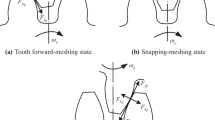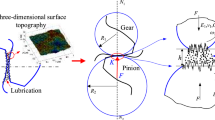Abstract
The modeling of elastohydrodynamic lubrication friction and the analysis of its dynamic effect on right-angle gears, such as hypoid and spiral bevel types are performed in the present study. Unlike the classically applied empirical constant coefficient of friction at the contacting tooth surfaces, the enhanced physics-based gear mesh friction model is both spatial and time-varying. The underlying formulation assumes mixed elastohydrodynamic lubrication (EHL) condition in which the division and load distribution between the full film and asperity contact zones are determined by the film thickness ratio and load sharing coefficient. In the proposed time-varying friction model, the calculation of friction coefficient is performed at each contact grid inside the instantaneous contact area that is being subjected to mineral oil lubrication. The effective friction coefficient and directional parameters synthesized from the net frictional and normal contact forces are then incorporated into a nonlinear time-varying right-angle gear dynamic model. Using this model, the effect of friction on the gear dynamic response due to the transmission error and mesh excitations is analyzed. Also, parametric studies are performed by varying torque, surface roughness and lubrication properties to understand the salient role of tooth sliding friction in gear dynamics. The simulation results are included. But experimental verification is needed.
Similar content being viewed by others

References
P. Velex and V. Cahouet, Experimental and numerical investigations on the influence of tooth friction in spur and helical gear dynamics, ASME Journal of Mechanical Design, 122(4) (2000) 515–522.
M. Vaishya and R. Singh, Sliding friction-induced nonlinearity and parametric effects in gear dynamics, Journal of Sound and Vibration, 248(4) (2001) 671–694.
P. Velex and P. Sainsot, An analytical study of tooth friction excitations in spur and helical gears, Mechanism and Machine Theory (2002) 641–658.
M. Vaishya and R. Singh Strategies for modeling friction in gear dynamics, Journal of Mechanical Design (2003) 383–393.
D. Downson, Elastohydrodynamics, Proceedings of the Conference on Lubrication and Wear, Inst. Mech Engrs (1967) 151–167.
D. Dowson and G. R. Higginson, Elastohydrodynamic Lubrication, Permagon, Oxford (1966) 139–181.
G. H. Benedict and B. W. Kelley, Instantaneous coefficients of gear tooth friction, ASLE Trans. (1961) 59–70.
J. P. O’Donoghue, J. P. and A. Cameron, Friction and temperature in rolling sliding contacts, ASLE Trans. (1966) 186–194.
Y. N. Drozdov and Y. A. Gavrikov, Friction and scoring under the conditions of simultaneous rolling and sliding of bodies, Wear (1967) 291–302.
B. R. Hohn and K. Steingrover, Local coefficients of friction in worm gear contacts, AGMA Fall Technical Meeting, Detroit, Michigan, October (1998).
Y. Michlin and V. Myunster, Determination of power losses in gear transmissions with rolling and sliding friction incorporated, Mech. Mach. Theory (2002) 167–174.
C. M. Denny, Mesh friction in gearing, AGMA Fall Technical Meeting, Detroit, Michigan, October (1998).
K. F. Martin, A review of friction predictions in gear teeth, Wear (1978) 201–238.
H. Xu, A. Kahraman, N. E. Anderson and D. G. Maddock, Prediction of mechanical efficiency of parallel-axis gear pairs, ASME Journal of Mechanical Design (2007) 58–68.
Y. Wang and H. Li, Transient thermoelastohydrodynamic lubrication analysis of an involute spur gear, Tribology International (2004) 773–782.
J. Castro, A. Campos, A. Sottomayor and J. Seabra, Gear friction coefficient in mixed lubrication, Proceedings of Leeds-Lyon Symposium on Tribology and interface engineering, Tribology Series 48, Life Cycle Tribology (2005) 525–536.
V. Simon, Influence of machine tool setting parameters on EHD lubrication in hypoid gears, Mechanism and Machine Theory (2009) 923–937.
J. Castro and J. Seabra, Coefficient of friction in mixed film lubrication: gears versus twin-discs, Proc.IMechE, PartJ: J. Engineering Tribology (2007) 399–411.
H. Xu and A. Kahraman, Prediction of friction-related power losses of hypoid gear pairs, Proc. IMechE Part K: Journal of Multi-body Dynamics (2007) 387–400.
S. Wu and H. S. Chen, A friction model of partial-EHL contacts and its application to power loss in spur gears, Tribology Transactions (1991) 398–407.
N. Ren, D. Zhu and S. Z. Wen, Experimental method for quantitative analysis of transient EHL, Tribology International (1991) 225–230.
Y. Cheng and T. C. Lim, Vibration analysis of hypoid transmissions applying an exact geometry-based gear mesh theory, Journal of Sound and Vibration (2001) 519–543.
Y. Cheng and T. C. Lim, Dynamics of hypoid gear transmission with nonlinear time-varying mesh characteristics, Journal of Mechanical Design (2003) 373–382.
J. Wang, T. C. Lim and M. Li, Dynamics of a hypoid gear pair considering the effects of time-varying mesh parameters and backlash nonlinearity, Journal of Sound and Vibration (2007) 302–329.
R. Li, and C. Huang, Tooth contact finite element analysis of spiral bevel and hypoid gears, Chinese Journal of Mechanical Engineering (1995) 82–86.
S. Vijayakar, Contact analysis program package: Calyx, Advanced Numerical Solutions, Hilliard, Ohio, USA, (2003).
T. Peng, Coupled multi-body dynamic and vibration analysis of hypoid and bevel geared rotor system, Ph.D Dissertation, University of Cincinnati (2010).
D. Zhu and Y. Hu, A computer program package for the prediction of EHL and mixed lubrication characteristics, friction, subsurface stresses and flash temperatures based on measured 3-D surface roughness, STLE Tribol.Trans (2001) 383–309.
B. J. Hamrock and D. Dowson, Isothermal EHL of point contacts, Part 3 full flooded results, ASME Journal of Lubrication Technology (1977) 264–276.
H. Winter and K. Michaelis, Scoring load capacity of gears lubricated with EP-oils, AGMA Fall Technical Meeting, Montreal, Canada (1983).
S. Bair and P. Kottke, Pressure-viscosity relationships for elastohydrodynamics, Tribology Transactions (2003) 289–295.
K. L. Johnson, J. A. Greenwood and S. Y. Poon, A simple theory of asperity contact in elastohydrodynamic lubrication, Wear (1972) 91–108.
J. A. Greenwood and J. B. P. Williamson, Contact of nominally flat surfaces, Proc. R. Soc. London (1966) 300–319.
Q. Liu, W. T. Napel and J. H. Tripp, Friction in highly loaded mixed lubricated point contacts, Tribology Transactions (2009) 360–369.
Author information
Authors and Affiliations
Corresponding author
Additional information
This paper was recommended for publication in revised form by Editor
Zhiheng Feng received his B.S. and M.S. degrees in college of Automation of Chongqing University, China, in 2003 and 2006, respectively. He is Ph.D Candidate in Mechanical Engineering from Chongqing University, China. Feng currently is a visiting Ph.D candidate at the department of Mechanical Engineering, University of Cincinnati, Cincinnati, Ohio, USA.
Shi-Long Wang received his B.S., M.S. and Ph.D degrees in Mechanical Engineering from Chongqing University, China, in 1988, 1991 and 1995, respectively. Dr. Wang currently is a Professor at the School of Mechanical Engineering, Chongqing University, Chongqing, China. He serves as a director of the Chinese Journal of Mechanical Engineering. Dr. Wang’s research interests include manufacturing automation, computer integrated manufacturing and enterprises informatization.
Teik C. Lim received his Ph.D degree in Mechanical Engineering from Ohio State University, USA. Dr. Lim currently is a Herman Schneider Professor and Department Head in Department of Mechanical Engineering, University of Cincinnati, USA. Lim’s research interests include design and dynamics of precision machine elements and gear noise and vibrations.
Tao Peng received his Ph.D degree in Mechanical Engineering from University of Cincinnati, USA. Dr. Peng currently is a project engineer in ArvinMeritor. Peng—s specialty areas include machine dynamics, vibration and noise, gear design and drivetrain engineering.
Rights and permissions
About this article
Cite this article
Feng, Z., Wang, S., Lim, T.C. et al. Enhanced friction model for high-speed right-angle gear dynamics. J Mech Sci Technol 25, 2741–2753 (2011). https://doi.org/10.1007/s12206-011-0803-3
Received:
Revised:
Accepted:
Published:
Issue Date:
DOI: https://doi.org/10.1007/s12206-011-0803-3



